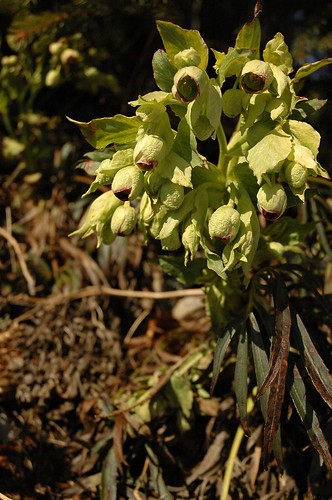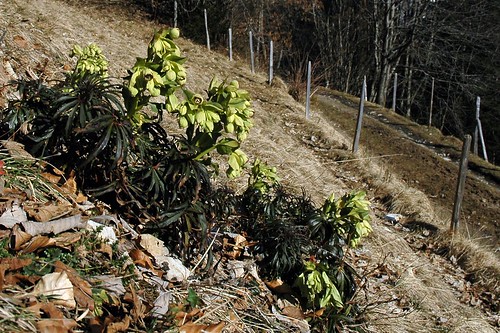
Als we het over Helleborus hebben, denken we gewoonlijk aan de witte Kerstroos (Helleborus niger) of de donkerrode H. orientalis.
Toch zijn er, tenminste in het zuiden van ons land, twee helleborussen in het wild te vinden: het stinkend nieskruid (H. foetidus) en (zeldzamer) de wrangwortel (H. viridis).
Die inheemse soorten hebben weliswaar minder opvallende groene bloemen, maar zeker het stinkend nieskruid vormt een opvallende verschijning in de wintertuin: Donkergroen blad, soms wat roodachtig aangelopen, waaruit een lichtgroene stengel tot 40 cm hoog oprijst, en daaraan een flinke bos lichtgroene bloemen met meestal een roodachtig randje, die mooi blijven vanaf het ogenblik dat ze zichtbaar zijn, tot ze rijp zaad gevormd hebben.
Helleborus is een geslacht in de ranonkelfamilie, net zoals het speenkruid en de boterbloemen, en bij de meeste helleborussen herken je ook wel dezelfde komvorm als bij die gele blommetjes. Maar bij het stinkend nieskruid vormt de bloem geen kom, maar hooguit een koffiekopje. Pas na de bloei gaat het bloempje zich meer uitspreiden, en dan wordt de verwantschap met de kerstroos overduidelijk. (Daarvoor is het nu te vroeg, die foto volgt nog…)

In de wortels van de leden van het geslacht Helleborus worden onder andere de glycosiden helleborine en helleboreïne. Dat zijn allebei digitalis-achtige stoffen, die dus een werking hebben op het hart (vandaar ook de giftigheid van Helleborus). Maar Helleboreïne is bovendien erg irriterend voor de slijmvliezen, en als het in aanraking komt met het neusslijmvlies, zal het tot niesbuien leiden.
De Romeinen kenden overigens twee planten, die ze ‘Helleborus‘ noemden. De ene is de Helleborus niger, onze kerstroos (die trouwens in het Duits ook wel ‘Schwarzer nieswurz’, zwart nieskruid wordt genoemd omwille van de zwarte wortel), en de andere is Veratrum album, witte nieswortel.
En inderdaad, het was omdat beide planten niesbuien konden uitlokken dat ze dezelfde naam – en hetzelfde medicinaal gebruik – kregen.
De kruiden werden ingezet bij psychiatrische ziektebeelden (en bij epilepsie). ‘Waanzin’ werd immers verondersteld verband te houden met een overmaat aan zwarte gal, en een prima manier om die zwartgalligheid wat te verminderen, was niezen… Dat wij nu nog steeds met ‘Gezondheid!’ reageren als iemand niest, zou daar trouwens verband mee houden.
En of het stinkend nieskruid stinkt? Ach, het heeft een wat scherpe geur, maar stinken zou ik het echt niet noemen…
(De foto’s in Zwitserland zijn gemaakt tijdens een bijna sneeuwvrije skivakantie, de andere maakte ik afgelopen maandag in onze tuin.)
Helleborus foetidus – Stinking hellebore, bearsfoot hellebore

But, in the Ardens, in the Southern part of Belgium, you can find two native members of the genus Helleborus: the Stinking Hellebore (Helleborus foetidus), and the much rarer Green Hellebore (Helleborus viridis).
In contrast with the well-known garden-varieties of H. niger and H. orientalis, our native Hellebores have less obvious green flowers. But nevertheless, the stinking hellebore, which is the more common species, is an impressive addition to the wintergarden. It has dark green foliage, often with a hint of red, and a rather tall, light green stalk with clusters of greenish flowers, that have a nice little red rim…
Helleborus is a genus in the buttercup-family (Ranunculaceae), just like – yes – buttercups and lesser celandine. And in many hellebores, you can easily recognize the saucer-shaped buttercup flower. But the Stinking Hellebore isn’t blooming as a saucer, but more like an elegant coffee-cup. Only when the seeds ripen, the flower is spreading and you can recognise the christmas-rose shape. (But I do not have that picture yet, as the plant is only recently introduced in my garden!)

Does it ‘stink’? Well, it does have a somewhat sharp scent, but it’s not strong, and I don’t want to call it ‘stinking’.
And why ‘Sneezewort’?
Well, the rhizomes of all hellebores contain helleborin and helleborein, two glycosides working like digitalin. But the latter, helleborein, is also strongly irritant to the mucous membranes, causing, when applied to the nasal membrane, sneezing.
In the Roman era, two plants were called ‘Helleborus’. One was Helleborus niger, our christmas roze, the other Veratrum album – and I just discovered, that in English this is still called ‘white hellebore’ (or white-flowered veratrum). For the Romans, they were both ‘Helleborus’ because they could be used for the same medical purpose: to induce sneezing.
Yes, indeed, sneezing as a cure… Helleborus was used in the treatment of several mental illnesses, that were considered to be caused by an excess of black bile (bile = chólos in Greek, hence ‘melancholia’). Sneezing was thought to reduce the amount of black bile.
And I don’t know if the custom exists in English speaking countries, but here, when someone sneezes, we often wish him ‘A good health!’ which could be a remnant of the old believe, that sneezing was beneficial.
(The pictures in Switserland were taken during a ‘skiing holiday’ with almost no snow, the other are made last monday in my garden.)
Op het moment staan in mijn stadstuintje, de Helleborus foetidus en argutifolius in bloei. Deze laatste plant verstrooit zijn zaden door de hele tuin. Overal komen stekken op, die na 2 jaar al weer grote planten zijn. Ook de Helleborus atrorubens bloeit bijna, de knoppen zie je al boven de grond komen. De wrangwortel staat nog op mijn verlanglijstje, ach ja, mensen en hun plantjes.
De H. viridis wil ik mij ook nog aanschaffen… Misschien eind maart, als ik EcoFlora weer eens ga bezoeken.
Wat een mooie foto, die eerste! Moet mij ook eens zo’n Helleborus foetidus aanschaffen. Misschien eind maart… :-)))
Dankjewel Bart…
Is het eerste ‘gevolg’ van mijn nieuwe macro-lens waar ik zelf ook wel over te spreken ben. (Compositie nog niet helemaal OK, bloempje wat te centraal, maar ik ben wel blij met de ‘diepte’ die er in het kelkje binnenin zit :-D)
I had a H. foetidus but lost it a few years ago. I must make the effort to replace it as I find all the Hellebores very attractive.
In England we say “Bless you” (short for “God Bless you”). The reasons seem to vary depending on the historical time line. Most people would probably relate it to the Great Bubonic Plague of the 14th century when sneezing was an early symptom of the disease. I suspect it was a recognition that death would follow soon rather than any idea that the blessing would help !
BTW thanks for commenting on my blog.
Thank you, I never heard this explanation, but it sounds indeed reasonably.
De eerste foto is schitterend. Ook in mijn tuin staat de Helleborus Niger.
Dan heb ik grote bewondering voor je, want dat is één van de meest lastige Helleborussen om hier in de tuin goed te laten gedijen… (Ik heb wel een paar H. orientalis, maar aan de H. niger heb ik me nog niet gewaagd.)
A most interesting and informative post Anne – I really enjoyed it.
I love these-all except the Christmas rose since that one died on my:(
I never tried the Christmas rose, since it is known to be the most difficult Helleborus to grow…